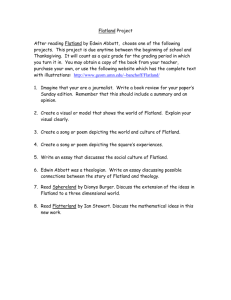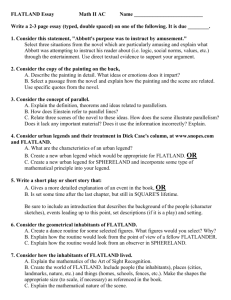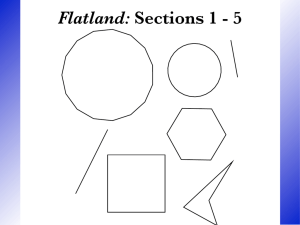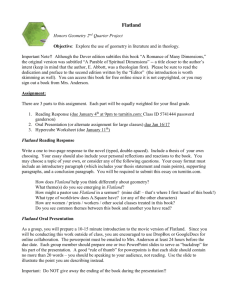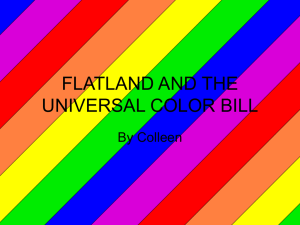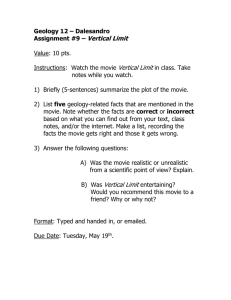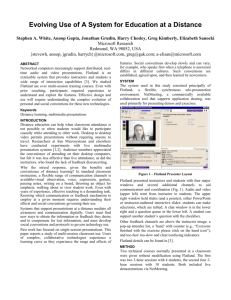Flatland Activity Worksheet flatland_activity_sheet.doc
advertisement
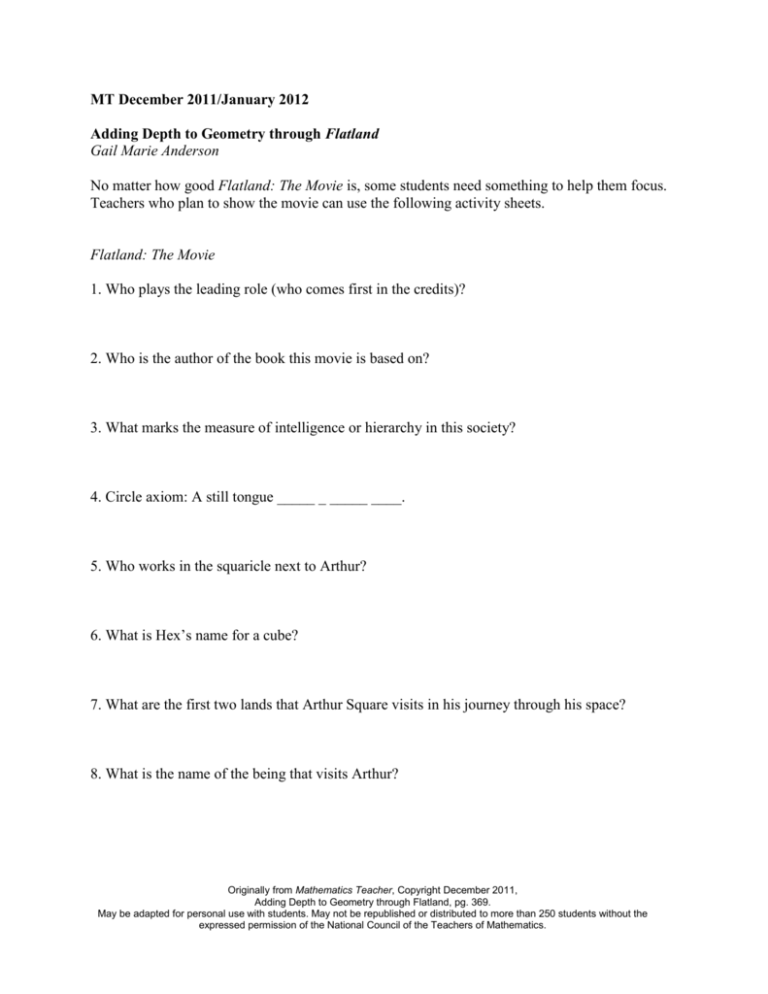
MT December 2011/January 2012 Adding Depth to Geometry through Flatland Gail Marie Anderson No matter how good Flatland: The Movie is, some students need something to help them focus. Teachers who plan to show the movie can use the following activity sheets. Flatland: The Movie 1. Who plays the leading role (who comes first in the credits)? 2. Who is the author of the book this movie is based on? 3. What marks the measure of intelligence or hierarchy in this society? 4. Circle axiom: A still tongue _____ _ _____ ____. 5. Who works in the squaricle next to Arthur? 6. What is Hex’s name for a cube? 7. What are the first two lands that Arthur Square visits in his journey through his space? 8. What is the name of the being that visits Arthur? Originally from Mathematics Teacher, Copyright December 2011, Adding Depth to Geometry through Flatland, pg. 369. May be adapted for personal use with students. May not be republished or distributed to more than 250 students without the expressed permission of the National Council of the Teachers of Mathematics. 9. What artifact from the third dimension was given to Flatland long ago and now resides in area 33H? 10. What blasphemous claim does Arthur Square make? 11. Does your sense of wonder extend only as far as your eye can see? 12. Add your comments on the movie here: Originally from Mathematics Teacher, Copyright December 2011, Adding Depth to Geometry through Flatland, pg. 369. May be adapted for personal use with students. May not be republished or distributed to more than 250 students without the expressed permission of the National Council of the Teachers of Mathematics. MT December 2011/January 2012 Adding Depth to Geometry through Flatland Gail Marie Anderson Flatland: The Movie (Answer key) 1. Who plays the leading role (who comes first in the credits)? (Martin Sheen) 2. Who is the author of the book this movie is based on? (Abbott) 3. What marks the measure of intelligence or hierarchy in this society? (size of angles or number of sides) 4. Circle axiom: A still tongue makes a happy life. 5. Who works in the squaricle next to Arthur? (his brother) 6. What is Hex’s name for a cube? (supersquare) 7. What are the first two lands that Arthur Square visits in his journey through his space? (Pointland, Lineland) 8. What is the name of the being that visits Arthur? (Spherius) 9. What artifact from the third dimension was given to Flatland long ago and now resides in area 33H? (cube) 10. What blasphemous claim does Arthur Square make? (that there is a third dimension) 11. Does your sense of wonder extend only as far as your eye can see? (Answers will vary.) 12. Add your comments on the movie here: (Answers will vary.) Originally from Mathematics Teacher, Copyright December 2011, Adding Depth to Geometry through Flatland, pg. 369. May be adapted for personal use with students. May not be republished or distributed to more than 250 students without the expressed permission of the National Council of the Teachers of Mathematics. MT December 2011/January 2012 Adding Depth to Geometry through Flatland Gail Marie Anderson Flatland: The Movie Honors 1. Make a list of differences that you observe between the movie and the book. 2. Write a paragraph reflecting on the differences identified above. Which did you like better— the movie or the book? Why? Did the movie help visualize the important concepts of the book? Did you like or dislike the changes the screenwriters made to the book? Why? What might you have done differently? (Answer any or all of these questions, but be sure to write a complete paragraph. Fill the available space; use the back if necessary). Originally from Mathematics Teacher, Copyright December 2011, Adding Depth to Geometry through Flatland, pg. 369. May be adapted for personal use with students. May not be republished or distributed to more than 250 students without the expressed permission of the National Council of the Teachers of Mathematics. MT December 2011/January 2012 Adding Depth to Geometry through Flatland Gail Marie Anderson Flatland: The Movie Honors Geometry Project Objective: Exploring the use of geometry in literature Flatland Oral Presentation As a group, you will prepare a ten-to-fifteen minute introduction to the movie version of Flatland. One person will be the group leader; this leader does not take part in the oral presentation but is instead responsible for compiling a PowerPoint slide show to accompany the presentation. The leader should coordinate the presentation and make sure it follows some sort of logical sequence or has a “flow” to it. Every other group member should prepare a sketch of one or two PowerPoint slides to serve as “backdrop” for his or her part of the presentation and give that to the leader. Important: Do not give away the ending of the book during the presentation! Some suggestions of topics to cover: Discuss how various shapes are used to represent various classes of people (this can be covered by more than one person if each person takes on a class). Give some background on the book and its author. As you watch the movie during class, you will see some glaring differences between the book and the movie. You will be asked to keep a list of these differences as well as give your opinions on the book versus the movie. Originally from Mathematics Teacher, Copyright December 2011, Adding Depth to Geometry through Flatland, pg. 369. May be adapted for personal use with students. May not be republished or distributed to more than 250 students without the expressed permission of the National Council of the Teachers of Mathematics. MT December 2011/January 2012 Adding Depth to Geometry through Flatland Gail Marie Anderson Flatland: The Movie Extra Credit Essay Options (choose 1) 1. What would the inhabitants of Flatland perceive if a cube rather than a sphere visited Flatland? How might this change have altered the book? 2. Several sequels have been written to Flatland, including Sphereland (Burger 1965), Planiverse (Dewdney 1984), and Flatterland (Stewart 2001). Read one of these and write an essay describing how this book continues the Flatland story as well as what new and interesting geometric perspectives are presented. 3. Planiverse covers many interesting technical details, such as how to play volleyball, open doors, and use zippers in two dimensions. Prepare an oral presentation or a poster on how some of these inventions work. You might want to invent something else in two dimensions instead, using the book as inspiration. Responses should be at least one page (double-spaced, typed) in length. The amount of extra credit awarded will vary according to depth of content, creativity, and geometric understanding demonstrated. Originally from Mathematics Teacher, Copyright December 2011, Adding Depth to Geometry through Flatland, pg. 369. May be adapted for personal use with students. May not be republished or distributed to more than 250 students without the expressed permission of the National Council of the Teachers of Mathematics.
